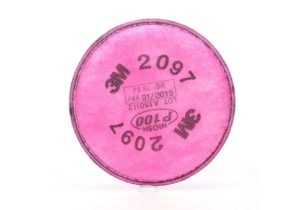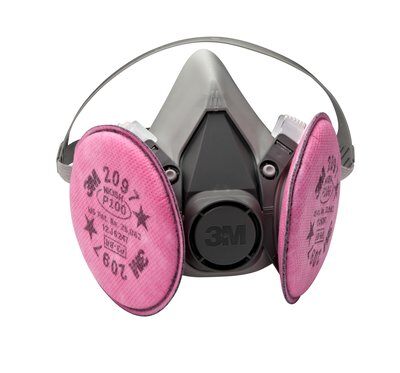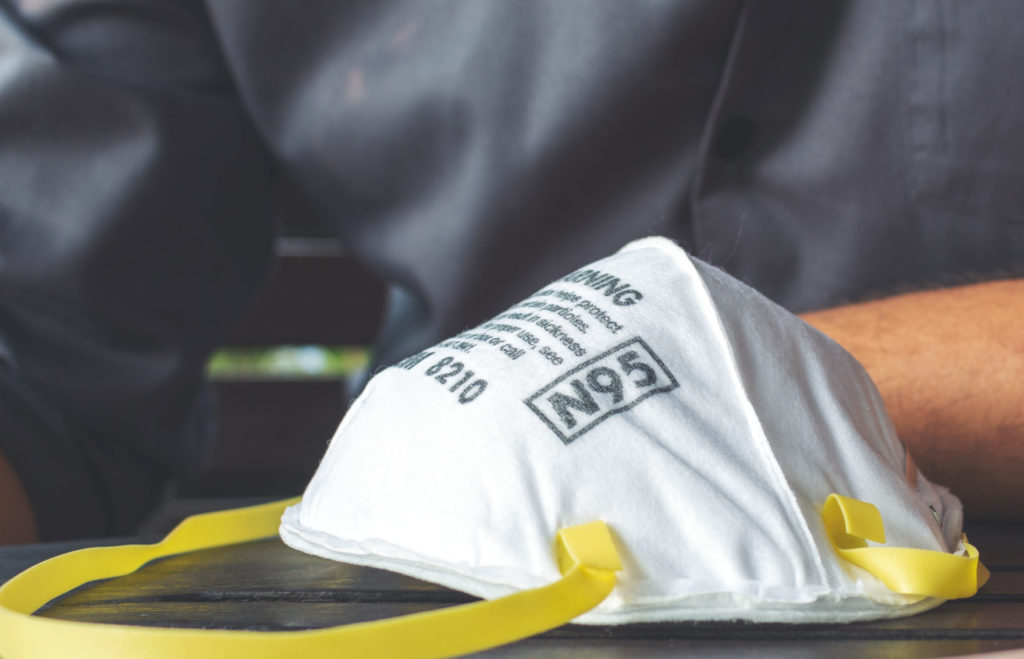
OSHA urges employers to consider alternatives to N95 masks
By onEducation | Legal | Market Trends | Repair Operations | Technology
3M has suggested collision repairers could use alternative respiratory protection during heavy demand for N95 masks, and the Occupational Health and Safety Administration on Friday offered a similar perspective.
“If respiratory protection must be used, employers may consider use of alternative classes of respirators that provide equal or greater protection compared to an N95 FFR, such as National Institute for Occupational Safety and Health (NIOSH)-approved, non-disposable, elastomeric respirators or powered, air-purifying respirators,” the Department of Labor wrote in a news release Friday.
OSHA said that even expired or even reused N95 masks could suffice if the alternatives weren’t available to a shop. However, GMG Envirosafe President Brandon Thomas on Friday said repairers should be able to obtain the alternative protection methods.
Doing so could help body shops protect employees, stay in compliance, and free up the N95 masks for health workers on the front lines of the disease.
“If respiratory protection must be used, employers may consider use of alternative classes of respirators that provide equal or greater protection compared to an N95 FFR, such as NIOSH-approved, non-disposable, elastomeric respirators or powered, air-purifying respirators (PAPRs),” OSHA Directorate of Enforcement Programs acting Director Patrick Kapust wrote in a Friday memo. “Other filtering facepiece respirators, such as N99, N100, R95, R99, R100, P95, P99, and P100, are also permissible alternatives for those who are unable to obtain N95 FFRs. However, per 29 CFR § 1910.134(d)(1)(ii), when considering N95 alternatives, check to ensure that they are NIOSH-approved, at www.cdc.gov/niosh/npptl/topics/respirators/disp_part/default.html. When these alternatives are not available, or where their use creates additional safety or health hazards, employers may consider the extended use or reuse of N95 FFRs or use of N95 FFRs that were NIOSH-approved but have since passed the manufacturer’s recommended shelf life.”
Kapust said the guidance Friday applied to industries in which “Protection of workers exposed to other respiratory hazards is impacted by the shortage resulting from the response to the COVID-19 pandemic. Such workplace respiratory hazards may be covered by one or more substance-specific health standards.”
3M, for example, has recommended auto body shops consider one of its reusable respirators fitted with replaceable P100 filters.
“One very good alternative is the BodyMan Respirator : Part number 7181 ( Small) 7182 (medium) and 7183 (large) — replacement filters are part number 7184. This mask handles grinding, sanding, welding, undercoating,” 3M business development manager Mark Algie wrote Monday to the Society of Collision Repair Specialists.
3M said it recommends the mask “for use in brake and clutch repair where asbestos exposures may be found.”
“The 3M™ Half Facepiece Respirator 07182 can be used for grinding, sanding, welding and brake and clutch repair applications,” 3M continued.
N95 masks filter out 95 percent of airborne particles but not oil, according to the Centers for Disease Control. P100 personal protective equipment blocks 99.97 percent of particles and is oil-resistant, according to the Centers for Disease Control.
P100 filters will provide respiratory protection for a technician grinding, working with body filler or welding, said Thomas. “You can do all of that,” he said.
Unlike N95 masks, a repairer should be able to obtain this kind of setup, according to Thomas.
“I haven’t heard of any shortages,” said Thomas, whose compliance firm also recently announced free COVID-19 training for the industry.
Thomas said PPE meeting the P95 (protection from 95 percent of particles and oil, according to the CDC) and P99 standards (protection from 99 percent of particles and oil) would also suffice for standard auto body work and should be available.
“It might be more expensive,” Thomas said. But repairers would receive “adequate or better protection” and free up N95 equipment for the health workers who needed it, he said.
“It’s for the best,” he said.
Thomas said many of his company’s clients weren’t using N95 masks anyway, but agreed they were common elsewhere in the body repair industry. A distributor ought to be able to help those shops find an OSHA-compliant alternative.
Thomas also noted that some states were demanding an inventory of personal protection equipment. Switching to an alternative respiratory protection method now would let shops “get out in front of it” in case the state ordered a repairer to turn over N95 masks for health care, he said.
To this point, OSHA might be temporarily loosening its rules — but it doesn’t seem to be suspending them. Based on the guidance Friday, repairers still must protect their employees despite these difficult times.
“All employers whose employees are required to use or are permitted voluntary use of respiratory protection must continue to manage their respiratory protection programs (RPPs) in accordance with the OSHA respirator standard, and should pay close attention to shortages of N95s during the COVID-19 pandemic.[5],” Kapust wrote. “Paragraph (d)(1)(iii) in section 1910.134 requires such employers to identify and evaluate respiratory hazards in the workplace, and paragraph (c)(1) requires employers to develop and implement written RPPs with worksite-specific procedures and to update their written programs as necessary to reflect changes in workplace conditions that affect respirator use. CSHOs should generally refer to CPL 02-00-158, Inspection Procedures for the Respiratory Protection Standard, 6/26/2014, for further guidance.[6]”
Using a vacuum system to capture particles might also protect employees from dust, Thomas said. But buying one might be impractible for a repairer given the current economic climate, he said.
OSHA also suggested repairers consider such alternative technology.
“Due to the impact on workplace conditions caused by limited supplies of N95 FFRs, all employers should reassess their engineering controls, work practices, and administrative controls to identify any changes they can make to decrease the need for N95 respirators,” Kapust wrote. “Employers should, for example, consider whether it is possible to increase the use of wet methods or portable local exhaust systems or to move operations outdoors. In some instances, an employer may also consider taking steps to temporarily suspend certain non-essential operations.”
As noted above, OSHA will allow respirators to be reused or worn for a prolonged time — but only if the alternative PPE wasn’t available.
“In the event extended use or reuse of N95 FFRs becomes necessary, the same worker is permitted to extend use of or reuse the respirator, as long as the respirator maintains its structural and functional integrity and the filter material is not physically damaged, soiled, or contaminated (e.g., with blood, oil, paint).[7],” Kapust wrote. “Employers must address in their written RPPs the circumstances under which a disposable respirator will be considered contaminated and not available for extended use or reuse. Extended use is preferred over reuse due to contact transmission risk associated with donning/doffing during reuse. When respirators are being re-used, employers should pay particular attention to workers’ proper storage of the FFRs in between periods of reuse. …
“If reuse of respirators is necessary, an appropriate sequence for donning/doffing procedures should be used to prevent contamination, and training needs to address appropriate donning/doffing procedures. See www.cdc.gov/niosh/npptl/pdfs/PPE-Sequence-508.pdf.”
OSHA also might permit expired respirators at the compliance officer’s discretion if a repairer follows certain guidelines. However, this can only be done if “N95s are not available and the employer has shown a good faith effort to acquire the respirators or to use alternative options.”
According to Kapust:
• Employers may use only previously NIOSH-certified expired N95 FFRs found at www.cdc.gov/coronavirus/2019-ncov/release-stockpiled-N95.html. Workers should be notified that they are using expired N95s.
• Purchasers and users of personal protective equipment should not co-mingle products that are past their manufacturer’s recommended shelf life (i.e., expired) with items that are within their shelf life.
• Employers should visually inspect, or ensure that workers visually inspect, the N95 FFRs to determine if the structural and functional integrity of the respirator has been compromised. Over time, components such as the straps, nose bridge, and nose foam material may degrade, which can affect the quality of the fit and seal.
• Where an employer has expired N95s available from their own stored cache (i.e., not from the U.S. Strategic National Stockpile), the employer should seek assistance from the respirator manufacturer or independent lab regarding testing of those stored respirators prior to use. (Minor formatting edits.)
Kapust said OSHA’s guidance took effect immediately but wouldn’t stand forever. “This guidance is intended to be time-limited to the current public health crisis,” he wrote.
More information:
Department of Labor, April 3, 2020
Occupational Safety and Health Administration, April 3, 2020
Free GMG Envirosafe COVID-19 coronavirus resources
“3M™ Half Facepiece Respirator Packout 07182, Medium, with 3M™ Particulate Filters PN 07184, P100” (Small 07181 and large 07183 masks also available)
Images:
A 3M P100 filter is shown. (Provided by 3M)
A medium-sized 3M half-facepiece respirator, part 01782, is shown. The one here uses P100 filters. (Provided by 3M)
An N95 mask is seen. (Memorystockphoto/iStock)


